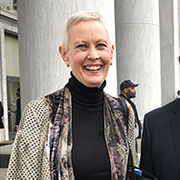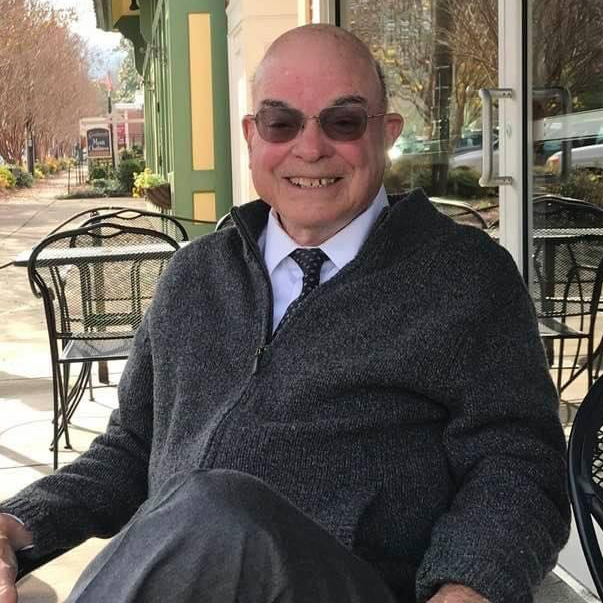When it comes to paying for innovative treatments, these two patients show that persistence pays off. Beverly crowd-funded her essential tremor treatment and raised $25,000. Perry advocated on behalf of her father for private insurance coverage.
Beverly: Crowd-Sourced Funding
 Beverly McGowan is a retired nurse practitioner who used a Go Fund Me page to crowdfund more than $25,000 for focused ultrasound treatment of her essential tremor. The procedure took place in June 2018, which was prior to nationwide Medicare approval. Over a period of about 6 weeks, 55 donors contributed $10 to $10,800. After the treatment, which took place at Stanford University Medical Center, Beverly made a 13-minute video about her experience to thank her friends and family. If there was no gap between FDA approval and Medicare reimbursement, Beverly’s treatment would likely have been paid for by Medicare.
Beverly McGowan is a retired nurse practitioner who used a Go Fund Me page to crowdfund more than $25,000 for focused ultrasound treatment of her essential tremor. The procedure took place in June 2018, which was prior to nationwide Medicare approval. Over a period of about 6 weeks, 55 donors contributed $10 to $10,800. After the treatment, which took place at Stanford University Medical Center, Beverly made a 13-minute video about her experience to thank her friends and family. If there was no gap between FDA approval and Medicare reimbursement, Beverly’s treatment would likely have been paid for by Medicare.
Read More about Beverly’s Story >
Perry and Dan: A Private Insurance Appeal
 When she saw the difference that focused ultrasound treatment could make for patients with essential tremor (ET), Perry Payne Millner advocated for her father, Dan Payne, to ensure that his private insurance would pay for the life-changing procedure.
When she saw the difference that focused ultrasound treatment could make for patients with essential tremor (ET), Perry Payne Millner advocated for her father, Dan Payne, to ensure that his private insurance would pay for the life-changing procedure.
In 2013, Perry was living in Charlottesville when she learned of a clinical trial for ET. Her father had suffered with tremors since 1993, when he was 55 years old. At that time, he stopped playing golf because he couldn’t control the club like he used to. The ET progressed every year. Unfortunately for Dan, the trial was closed, and the procedure would cost $30,000 out-of-pocket. Her father decided to wait until Medicare approved the treatment; they had no idea it would take six years.
“The Medicare coverage should have been approved one year earlier than it was,” Perry said. “Paperwork glitches and Medicare deadlines caused delays, but early in January 2019, the approvals came through and we jumped on it.”
Although Dan had enrolled in Medicare, he also had private health insurance. To secure coverage, the family first called Medicare, which they found would ultimately cover all but $7,500.
The private insurance provider, affiliated with the regional hospital system, said it would cover up to $15,000, but getting that coverage was cumbersome. “We had to get letters from two of dad’s doctors, with supporting forms and recommendations, to be reviewed by a panel. We completed the paperwork and submitted it to the insurance company in January or February, where the package sat and sat,” Perry recalls. After countless phone calls and many, many weeks she drove to the office and found a helpful person to take up the family’s cause. Upon review, and after almost four months, the contact at the insurance company told her that her father’s file was incomplete and that his doctors would have to fill out another form. The insurance company had not asked the doctors (Dan’s internist and cardiologist) to submit the needed forms.
“Apparently, the doctors have to fill out this form any time they recommend a treatment,” said Perry. Losing patience, she made it her personal mission to see the process through. “I went to both doctors’ offices. Both told me to come back later. I declined. I asked each of them to send down a nurse or someone to sign these forms—I told them ‘I’ll wait.’ I waited an hour in one office and 90 minutes in the other. I did not leave until the forms were signed.”
Forms in hand, she proceeded immediately to the insurance office, where she was told a panel would meet to approve Dan’s treatment. The “panel,” she discovered, was a sole nurse practitioner on staff. Perry asked the nurse practitioner to meet her in the lobby, on the spot. “Again, I said, ‘I’ll wait,’” said Perry. “I might have been pushy, but we’d been waiting six years already. My dad was not getting any younger!”
The panel approved the treatment and gave Dan one month from that day to see Dr. Elias at the University of Virginia (UVA) in Charlottesville. “I called UVA for an appointment and told her that my dad had one month to commence treatment,” said Perry, who was astonished to learn that the waiting list was four years long! “When I told her that we had been working on this since 2013 and was able to provide proof of our conversations, Dad was moved to the top of the waiting list.” Even more amazing was that another patient with treatment scheduled for the next month had to cancel; Dan was more than happy to take his spot.
Because the treatment planning appointments took about a month to complete, Perry was able to secure an extension from the insurance company for her dad’s treatment date. Dan was finally treated in July 2019, only four months after his insurance approvals came through.
“My takeaway is that older patients need someone to advocate for them,” says Perry. “They need help with the paperwork, the technology, the insurance. My dad’s generation has such respect and reverence for physicians; they don’t want to rock the boat or seem pushy. But somebody has to get past the red tape and through the bureaucracy.” Dan’s story ended happily. “In the end, I don’t think he paid a penny out of pocket,” Perry reports. He’s 82, and only retired in September of this year.
“At lunch on the way to UVA for his treatment, I watched my dad try to cut into an eclair—his tremor sent the plate flying across the table,” said Perry. “He wouldn’t eat in the dining room at the hospital because he thought the powers that be would notice his disability and make him quit working.” He is happy to report that his quality of life is much improved. Happily, “He can go to a cocktail party and hold both drink AND plate,” his daughter chuckles. He was excited to retire this fall so he can enjoy life and family more. “It’s a happy ending for sure,” she reports.
Editor’s note: Dan Payne fully retired in September 2020 and is doing well one year after the treatment, which did reveal some gait and balance problems. He is working through physical therapy and exercise to regain the unilateral loss in balance and strength that he experienced. Overall, his quality of life is much improved. It is Dan’s understanding that his private insurance ultimately covered all or nearly all the expenses. He didn’t pay a penny out of pocket.
